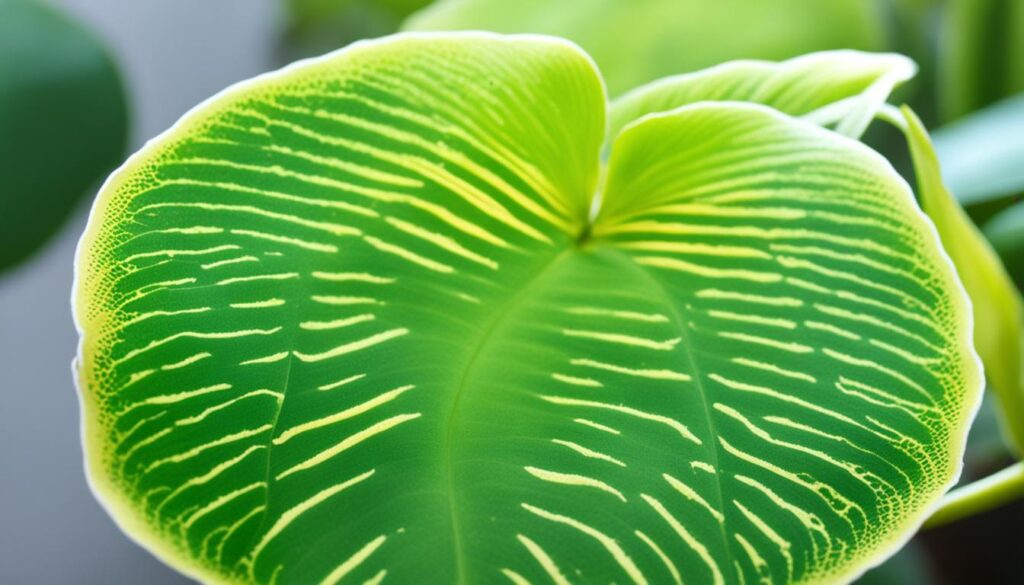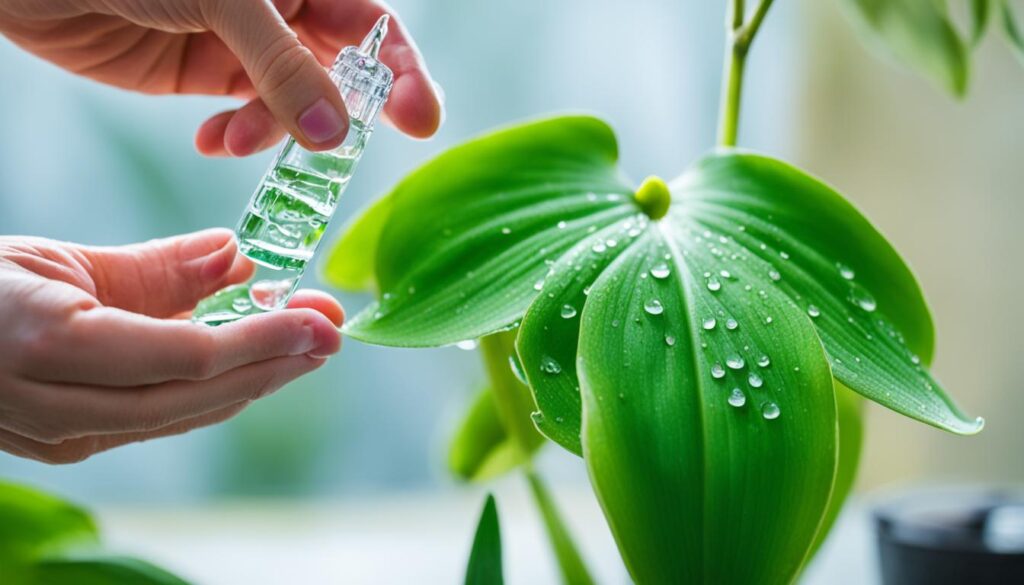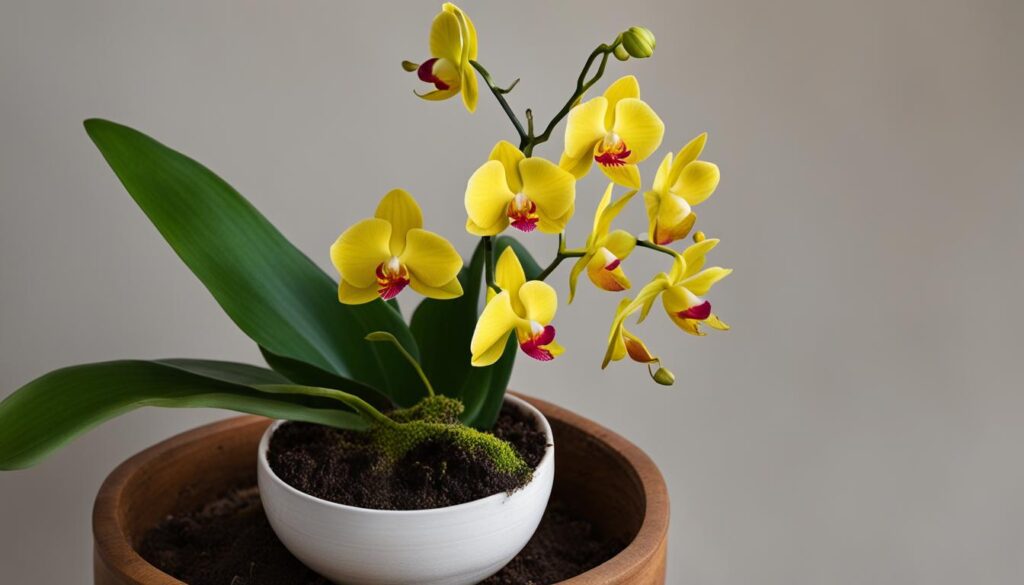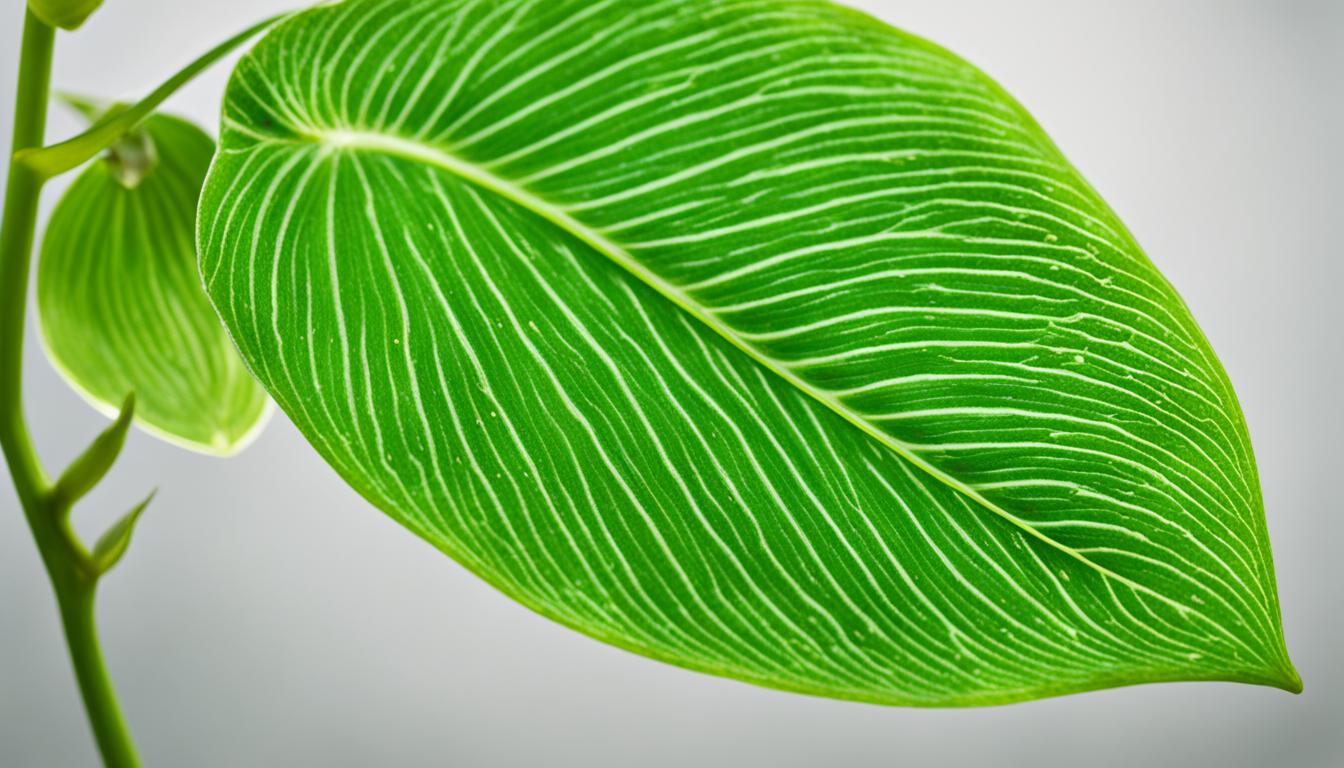Believe it or not, each year, admirers across the United States spend over $280 million on orchids.
Yet, even the most luxurious orchids are not immune to distress signals such as yellow orchid leaves. As an enthusiast, I understand the dismay you may feel when your orchid’s once lush greenery begins to fade into a concerning yellow.
The yellowing of orchid leaves can be caused by various stressors, ranging from natural aging to more alarming environmental factors.
Whether you’re facing yellowing orchid leaves treatment dilemmas or just seeking general orchid care yellow leaves advice, I am here to guide you through the ins and outs of how to fix yellow orchid leaves and restore your vibrant blooms to their former glory.
Phalaenopsis orchids, the variety most commonly adorning our homes, have a particular way of communicating their needs.
Yellowing leaves may signal that it’s time to reassess your care routine, potentially altering light exposure, watering habits, or even your fertilization strategy.
Acknowledging these botanical cues promptly can make all the difference in rejuvenating your precious plant.
Key Takeaways
- Identify if yellowing is part of the natural aging process or indicates potential stressors.
- Avoid placing orchids in excessive direct sunlight to prevent leaf damage.
- Regularly check for proper watering, ensuring the top inch of soil is dry before re-watering.
- Maintain ambient temperatures and humidity levels to match orchids’ natural habitat conditions.
- Act promptly to shift potting mixes or introduce treatments if pests or diseases are present.
- Understand nutritional needs and adjust fertilization to prevent leaf yellowing.
Understanding Orchid Leaf Health
As an orchid enthusiast, I often encounter questions about the health of orchid leaves, particularly when they start exhibiting colors of yellow and brown.
Discerning the signs of a thriving orchid from those in distress is essential for proper care and maintenance.
Let’s delve into what indicates robustness in these exotic plants and signs that alert you to potential problems.
Signs of Healthy Orchid Leaves
A flourishing Phalaenopsis orchid has leaves that are plump and taut, demonstrating a glossy and vivid green hue. It’s a spectacular sight for any grower.
These leaves are indicative of a plant enjoying optimal conditions. Even when the orchid’s stem lengthens as bottom leaves are shed, the emergence of new roots signifies ongoing health and vigor, nature’s own sign of approval.
Signs That Something’s Wrong
Sadly, not all changes in leaf color are part of the natural growth process. When an orchid leaf turns yellow and brown, it’s a visual alarm bell.
The top leaves shouldn’t yellow prematurely, and if they do, it could signal too much light or an imbalance in watering.
A yellow orchid leaf, particularly with accompanying brown spots, may indicate a yellow orchid leaf disease or a pest infestation.
Both scenarios can have serious implications and often require intervention, from cutting away rotting roots to employing specific fungicides or horticultural oils.
Another symptom not to overlook is the presence of yellow spots on orchid leaves.
These can be the first signs of fungal infections or an initial warning that pests have begun to take up residence.
Prompt, targeted action, such as increasing air circulation around the plant and improving hygienic practices, can often prevent these concerns from escalating.
Should you encounter these issues, don’t despair. With careful examination and the correct care approach, you can often nurse your orchid back to health, and once again enjoy the splendor of its vibrant green foliage, a testament to both its resilience and your attentive stewardship.
Comprehensive Guide to Yellowing Orchid Leaves: Causes and Treatments
If you’re noticing yellow orchid leaf tips or other discoloration in your plant’s foliage, you’re likely dealing with a common but troubling issue: why are my orchid leaves turning yellow?
Orchid care often hinges on identifying the underlying causes and knowing how to fix yellow orchid leaves effectively.
Before diving into specific causes, it’s important to understand that various factors contribute to yellowing leaves, ranging from light exposure and water practices to nutritional deficiencies and environmental stressors.

Light Exposure: Finding the Balance
Proper light is vital for your orchid; too much can scorch the leaves, while too little stunts growth.
To correct light-related yellowing, ensure your plant receives bright but indirect sunlight, ideally in an east-facing window where the morning light is gentle.
Temperature Fluctuations and Their Effects
Maintaining an optimal temperature range between 65-80°F (18-27°C) during the day and 60-70°F (15-21°C) at night supports orchid health.
Avoid placing your plant near heat sources or drafts that cause significant temperature swings.
The Impact of Watering Practices
Orchids require a careful balance of moisture. Overwatering leads to root rot, while under-watering can lead to dehydration.
It’s essential to water only when the top inch of the potting medium is dry to the touch.
Humidity and Orchid Health
Orchids thrive in humidity levels of 40-70%. You may need to use a humidifier or humidity tray, especially in dry conditions, to keep the leaves vibrant and prevent them from turning yellow due to lack of moisture.
Potting Practices and Stress Reduction
Yellow leaves can signal stress from stale or unsuitable potting media.
Use a well-draining orchid mix and repot every few years to ensure the roots have the air circulation and structure they need to stay healthy.
Identifying Nutritional Needs and Deficiencies
Nutritional deficiencies can cause yellow leaves. Orchids benefit from regular applications of fertilizer balanced in nitrogen, phosphorus, and potassium, especially during the growing season.
Recognizing and Treating Diseases
Diseases can cause yellowing and require prompt treatment with fungicides. Removing affected leaves and improving air circulation can prevent the spread of pathogens.
Dealing with Pests: Prevention and Treatment
Inspect your orchids regularly for pests and treat infestations with appropriate insecticides or natural methods like neem oil to halt leaf yellowing caused by these invaders.
Environmental Changes and Shipping Stress
Sudden changes in the environment, such as repotting or home relocation, can lead to stress-related yellowing.
Gradually acclimating your orchid to new conditions can mitigate this issue.
The Natural Aging Process
Finally, it’s natural for the lower leaves of an orchid to occasionally turn yellow and fall off as the plant ages.
This is part of the normal life cycle and shouldn’t cause alarm.
Preventive Measures for Healthy Orchids
To safeguard the vibrant lushness of orchid foliage and avert the onset of yellowing leaves, I engage in a set of proactive measures.
Beginning with careful watering practices to stable environmental controls, each step is essential in ensuring the brilliance and health of these sensitive plants.
Optimal Watering Techniques
Understanding that overwatering is just as detrimental as dehydration, I implement the ‘three ice cubes’ method.
This simple, measured approach provides my orchids with adequate moisture without overwhelming their roots, a common factor that can lead to orchid care yellow leaves.

Ideal Light Conditions
My home’s north and west-facing windows offer the perfect harbor for my orchids.
They bathe in the gentle, indirect light these exposures provide, safe from the harshness of direct sunlight known to instigate yellow orchid leaf disease.
Temperature Control for Orchids
I keep a vigilant eye on the thermometer to ensure a stable climate akin to their tropical origins, far removed from chilling drafts or the arid zones created by heating and cooling systems, which might cause yellow spots on orchid leaves.
Maintaining Proper Humidity Levels
Ambient moisture levels are a critical aspect of my indoor orchid care. A humidity tray or a dedicated humidifier keeps the atmosphere within that orchid-idyllic range of 40%-70%.
It’s a simple practice that makes a significant difference in preventing and knowing how to fix yellow orchid leaves.
Nutrient Management and Fertilization
I adhere to a fertilization schedule with diligence, employing a balanced orchid fertilizer during the growth season.
This approach ensures my orchids are replete with all necessary nutrients, thwarting the occurrence of nutrient deficiency-related yellowing leaves.
| Care Aspect | Techniques for Prevention | Effect on Orchid Health |
|---|---|---|
| Watering | ‘Three ice cubes’ method, ensuring adequate drainage | Prevents root rot and yellowing due to overwatering |
| Lighting | Position in indirect light from north/west-facing windows | Avoids leaf burn and related yellowing |
| Temperature | Maintain stable temperatures, away from drafts/vents | Reduces stress-induced yellowing |
| Humidity | Use of humidity trays or humidifiers | Maintains healthy leaf color and texture |
| Fertilization | Regular application of diluted orchid fertilizer | Prevents yellowing from nutrient deficiencies |
Addressing Orchid Yellow Leaves: Step-by-Step Solutions
If you’ve discovered yellow orchid leaves, don’t panic! I’m here to guide you through a methodical approach to restoring your plant’s lush green vibrancy.
By carefully examining your orchid, you can identify the root of the issue and take corrective measures. Here is a structured plan that will help you tackle the problem effectively.
Diagnosing the Cause of Yellow Leaves
The initial step is to thoroughly inspect your orchid. Look for patterns in the yellowing, are the yellow spots on orchid leaves localized or widespread?
Observe for conditions such as overexposure to light, extreme temperatures, or erratic watering schedules.
Inadequate humidity or poor potting practices may also contribute to the discoloration of the leaves.
Nutrient deficiencies shouldn’t be overlooked; they often manifest as yellow leaves in orchids.
Tailored Treatments for Yellowing Leaves
Once you determine the cause of the yellow orchid leaves, address it through specific adjustments summarized in this handy table:
| Cause | Symptom | Treatment |
|---|---|---|
| Overexposure to Light | Yellow leaves with brown tips | Relocate to indirect sunlight |
| Temperature Stress | Yellowing of new leaves | Stabilize temperature within 65-80°F |
| Improper Watering | Soft, yellow leaves | Water only when the top inch of soil is dry |
| Low Humidity | Dry, yellow leaves | Use a humidifier or humidity tray |
| Poor Potting Practices | Uniformly yellow leaves | Repot with proper orchid media |
| Nutrient Deficiency | Yellowing, particularly on new growth | Apply a balanced orchid fertilizer |
For issues beyond basic orchid care yellow leaves protocols, such as pest infestation or disease, consult a specialist for the appropriate fungicide or insecticide treatment.
Through meticulous care and loving attention, your orchid can flourish and regain its former beauty.

When to Seek Professional Help
As an orchid enthusiast determined to maintain a verdant and blooming collection, I’ve come to realize not all leaf-yellowing issues can be solved through traditional home care remedies.
Sometimes, when I observe the yellowing of my orchid leaves, it’s a signal that more serious problems may be lurking beneath the surface.
I know that deciphering when to reach out for professional assistance is as important as any step in my plant care routine.
It’s particularly true if the path to how to fix yellow orchid leaves isn’t clear, or if the symptoms suggest a potential yellow orchid leaf disease.
Identifying When Yellow Leaves Indicate Serious Problems
My keen observation skills come into play when I notice distressing signs on my plants.
If the yellowing is accompanied by ominous signals like a stench, a slimy feel, or a troubling black coloration, my alarm bells ring.
This is usually indicative of a grave bacterial or fungal issue, far beyond what traditional TLC can handle. It’s these kinds of scenarios that push me to look beyond my capabilities and seek professionals who are experienced in diagnosing why are my orchid leaves turning yellow with such severity.
I understand that swift action is key to potentially saving my precious orchids from imminent decline.
Consulting with Orchid Experts
When I face a persistent problem that resists my preventive measures and remedies, I don’t hesitate to consult an expert.
Visiting a local nursery or reaching out to a professional orchid grower provides a wealth of specialized knowledge and advanced treatment options.
I recognize the value of their expertise in saving my plants and ensuring they return to a state of health and vibrancy. Their guidance is crucial, especially when the challenge seems insurmountable to an amateur.
In such cases, professional intervention is not an expense but an investment in the well-being of my cherished orchid collection.


Leave a Reply